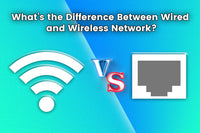Wi-Fi technology has been one of the main ways to make you access the Internet. In recent years, Wi-Fi has been rapidly developed to meet the requirement of many families and businesses. The introduction of Wi-Fi 6 is an advanced version of WLAN technology, but the unreleased Wi-Fi 7 will be a giant leap.
What are the differences between Wi-Fi 6 and Wi-Fi 7? Is Ethernet cable still prevalent nowadays? Let’s have a look.
What is Wi-Fi 6?
Wi-Fi 6, or 802.11ax, is an IEEE standard for WLANs. Wi-Fi 6 has a large improvement with the introduction of OFDMA, bi-directional MU-MIMO, and higher efficiency. Wi-Fi 6 can reach the speed of 9.6 Gbps (maybe faster), and it can operate in both 2.4 and 5 GHz frequencies. Compared to the previous versions, Wi-Fi 6 has made a significant advancement. It is specifically designed for high-density applications such as large businesses, shopping malls, and apartments.
What is Wi-Fi 7?
Wi-Fi plays an important role in the home and office network, and it has become the main method of getting access to Internet. In recent years, new applications have had higher requirements for throughput and latency and Wi-Fi 6 cannot fully meet these needs. Wi-Fi 7 is expected to support larger throughput and it will be released in 2024.
Wi-Fi 7 will be the next generation of Wi-Fi standards, and it is also known as 802.11be. Wi-Fi 7 has many innovative improvements, including the introduction of 320 MHz bandwidth, 4K-QAM, Multi-RU, and enhanced MU-MIMO. Compared to Wi-Fi 6, Wi-Fi 7 performs better in many scenarios, such as 4K and 8K videos (the transmission speed can reach 20 Gbps), VR/AR, gaming, remote work, online conferences, and cloud computing.

Wi-Fi 6 vs. Wi-Fi 7: What’s the Difference?
Before learning the differences between Wi-Fi 6 and Wi-Fi 7, you need to know the definition of “band,” “channel,” and “stream.” There are three common Wi-Fi frequency bands: 2.4GHz, 5GHz, and 6GHz. If you find it difficult to understand, you can regard these bands as country roads, major district roads, and national highways. And “channel” means the width of each traffic lane. Lane width is determined by the width of the road. Even if the country road can be divided into three lanes, each lane cannot hold large vehicles. “Stream” is like the size of cars. The larger the vehicle and the wider the road, the more goods can be carried; that is, more data can be transmitted. Now you understand throughput better, and we’ll tell you how Wi-Fi 7 outperforms Wi-Fi 6.
Channel Width
Wi-Fi 6 has a maximum channel bandwidth of 160MHz and a transmission speed of 1.2 Gbps. Wi-Fi 7 is designed to use twice the channel width, meaning that it has a transfer speed of 2.4 Gbps. Theoretically, each stream supports 2.4 Gbps, and Wi-Fi 7 supports 16 spatial streams, so Wi-Fi 7 can deliver data at 40 Gbps. Wi-Fi 7 has a higher speed than Wi-Fi 6 as it has a larger throughput.
4K-QAM
Quadrature Amplitude Modulation (QAM) is a method of transmitting data to the receiving device. The denser the modulation, the larger amount of data can be transferred. Wi-Fi 6 supports 1024-QAM, while Wi-Fi 7 is expected to support 4096-QAM (also known as 4K-QAM). So Wi-Fi 7 can be the best choice for AR/VR, 4K, and 8K videos.

Efficiency
Wi-Fi 6 supports bidirectional MU-MIMO and 8 spatial streams, meaning that it allows eight connections to access the Internet at the same time without losing transmission speed. Wi-Fi 7 can support 16 spatial streams, which allows more devices to access the Internet. Wi-Fi 7 also introduces CMU-MIMO so that 16 streams can be offered by multiple access points.
The Wi-Fi 7 technology also uses Multi-RU, enabling a single user to be allocated multiple RUs. Multi-RU can make use of additional channels to optimize the utilization of resources.
Multi-Link Operation
In general, one frequency band can only be used at a time, but Wi-Fi 7 is expected to combine two frequency bands as a single connection. In addition, the connection to Wi-Fi 6 is fixed to a specific channel and you can not change one channel to another. But in Wi-Fi 7 technology, channels can be automatically changed to get the best performance. So, Wi-Fi 7 can provide higher throughput and lower latency.
Security
Wi-Fi 7 includes enhanced security features such as WPA3-Personal, WPA3-Enterprise, and Enhanced Open. These features provide better encryption and authentication protocols to protect against security threats.
Wi-Fi Versions
The first version of Wi-Fi was released in 1997 and then Wi-Fi has made much advancement.

Is Ethernet Cable Outdated Today?
The oncoming Wi-Fi 7 has a higher speed, and Wi-Fi technology will be increasingly popular for its convenience. Is Ethernet cable outdated today? The answer is definitely not.
Wi-Fi uses ‘half-duplex’ mode, meaning it can only transmit data in one direction at a time, but the data can be sent simultaneously in both directions via an Ethernet cable. In addition, Wi-Fi can be easily affected by external interference and is not as secure as a wired connection.
Compared to Wi-Fi, Ethernet cables provide a faster, more stable, and more secure network. They are terminated with RJ45 connectors, keystone jacks, or field termination plugs for high-speed and stable network connection. People who often use desktop computers and gaming consoles will definitely choose Ethernet cable. Ethernet cables have been continuously upgraded and now it has developed to CAT8, which can reach the speed of 40Gbps.
Wi-Fi technology and Ethernet cable have their own pros and cons. Wi-Fi technology benefits mobile devices and it will be linked to Ethernet for future-proof.
For more information on this topic, you can keep up on our blogs. While VCELINK offers general and basic information for our customers and other visitors to the website, it’s not professional advice.





Be the first one to comment.
Leave a comment